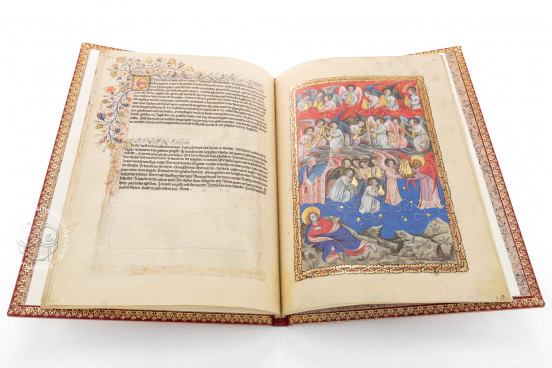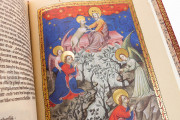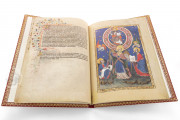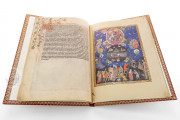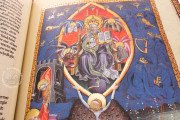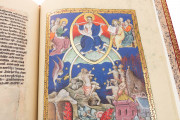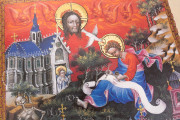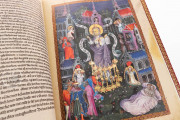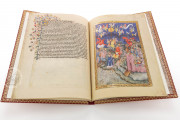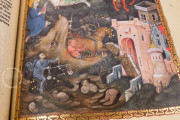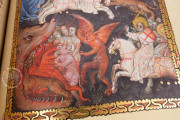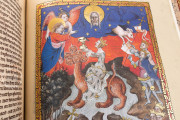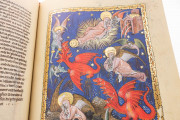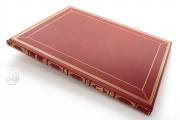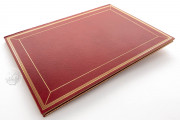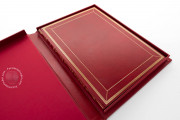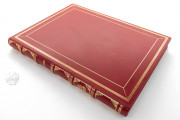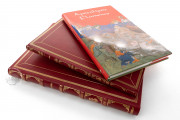An unrivaled masterwork of Gothic painting, the Flemish Apocalypse is exceptional in the tradition of illuminated Apocalypse manuscripts. Created between 1400 and 1410 by two illuminators of outstanding technical ability, the repertoire of twenty-three full-page miniatures offer unprecedented and innovative interpretations of the Apocalypse tradition. Instead of the conventional series of illustrations distributed throughout the chapters of the Book of Revelation, the artists compressed multiple events from each chapter into a single exuberant scene set opposite its corresponding chapter, forming a series of diptychs of text and image. Executed with a high degree of naturalism that only emphasizes the chaotic and visionary character of the Apocalypse, the illuminations are a remarkable technical achievement. Refined and original, the Flemish Apocalypse transports the biblical events of the Apocalypse into daily medieval life.
In addition to the Book of Revelation, the Flemish Apocalypse includes five excerpts from a related religious text, all in Middle Dutch. Just seven Apocalypse manuscripts in Middle Dutch are known, and of these the Flemish manuscript is the only illuminated one. Decidedly unique, this manuscript might be the sole survivor of a distinct Flemish tradition.
A Unique Witness to an Apocalypse Tradition
The visual sequence of the Flemish Apocalypse begins with a frontispiece of the life of St. John followed by twenty-two full-page illuminations, one for each chapter of the Book of Revelation. The paintings feature a high narrative content, condensing many episodes into a single scene set within a unified setting.
The naturalistic details, including the lifelike movement of personages, the technically accurate construction of sea vessels and flamboyant Gothic architecture, and the foliage and flowers scattered around the landscapes, make this manuscript an indispensable example of pre-Eyckian realism.
Equally masterful is the varied and intense palette, applied thickly with virtuosic control of shading and tone. Gold enriches details of the compositions and their frames. Two distinct hands have been identified, with the first illuminator responsible for fols. 1–6 and the second fols. 7–23. Neither of these exceptionally talented miniaturists has been identified in other works.
Gothic Script in Flower
The Flemish Apocalypse is written in a semi-formal, very angular Gothic textualis with pronounced biting and fine hairline serifs. The script is regular and legible, densely packed into a single column to accommodate a full chapter of text per page.
Two scribal hands can be discerned, of which the principal wrote all but one of the folios, while all decoration was executed by the illuminators. Each chapter begins with a large initial painted in pale pink, blue, and gold and finely detailed with white; from these initials sprout elaborate vines that frame the texts, bearing an abundance of leaves, flowers, birds, and rabbits.
Smaller gold and red initials with hairline vines open the shorter passages. At the end of the manuscript, the list of letters of indulgences is elaborated with simple initials in alternating blue and red.
An Uncharted History
The history and provenance of the Flemish Apocalypse are entirely unknown. It was purchased by the Bibliothèque nationale de France in 1827.
We have 2 facsimiles of the manuscript "Flemish Apocalypse":
- Apocalipsis Flamenco (Parchment Facsimile) facsimile edition published by Scriptorium, 2020
- Apocalipsis Flamenco facsimile edition published by M. Moleiro Editor, 2004

